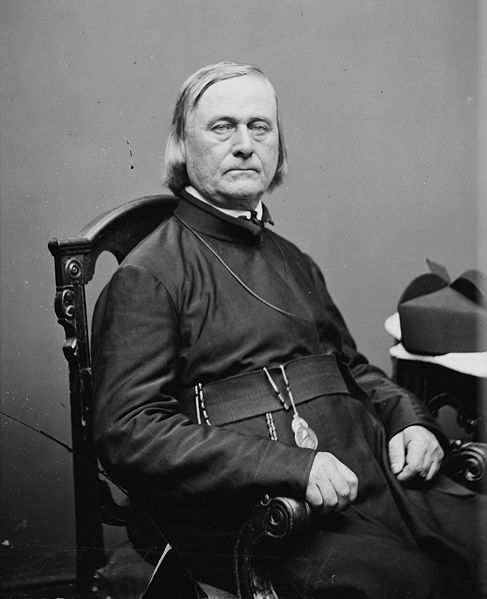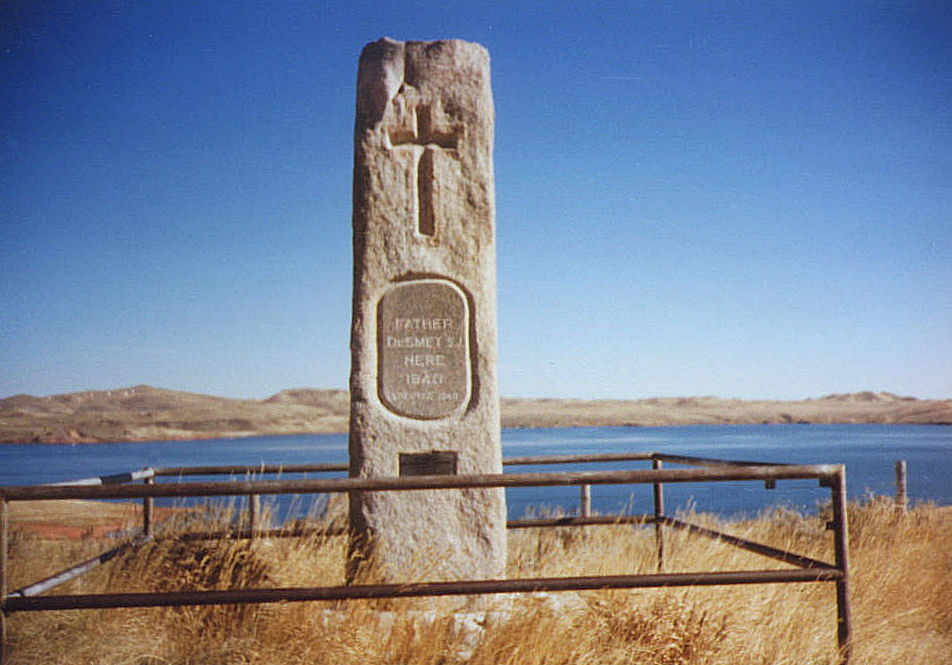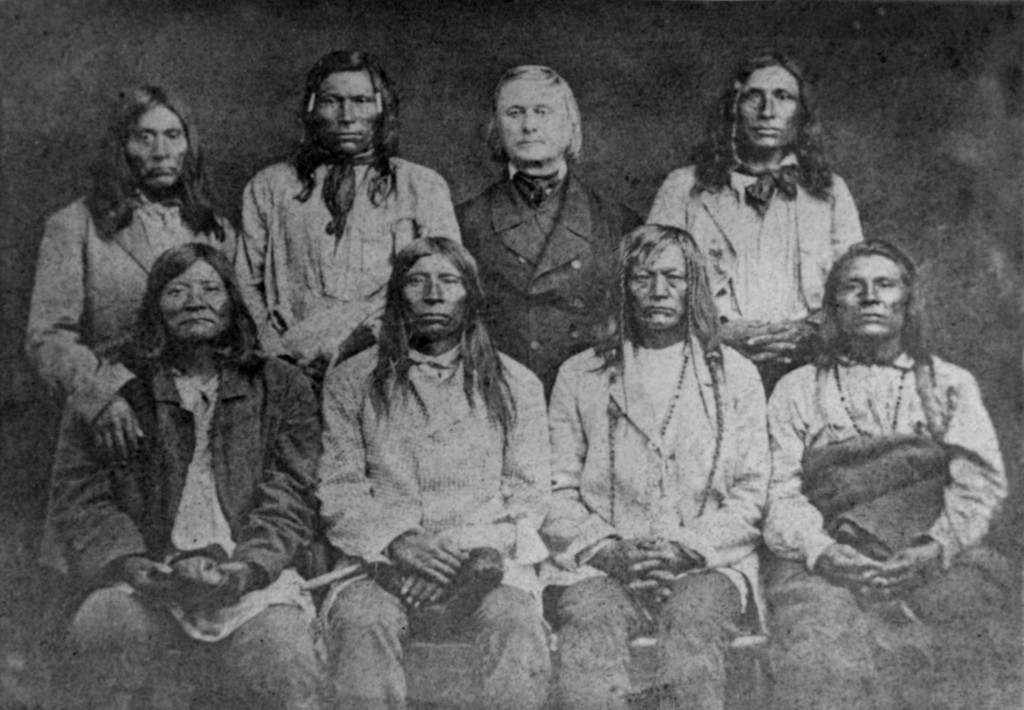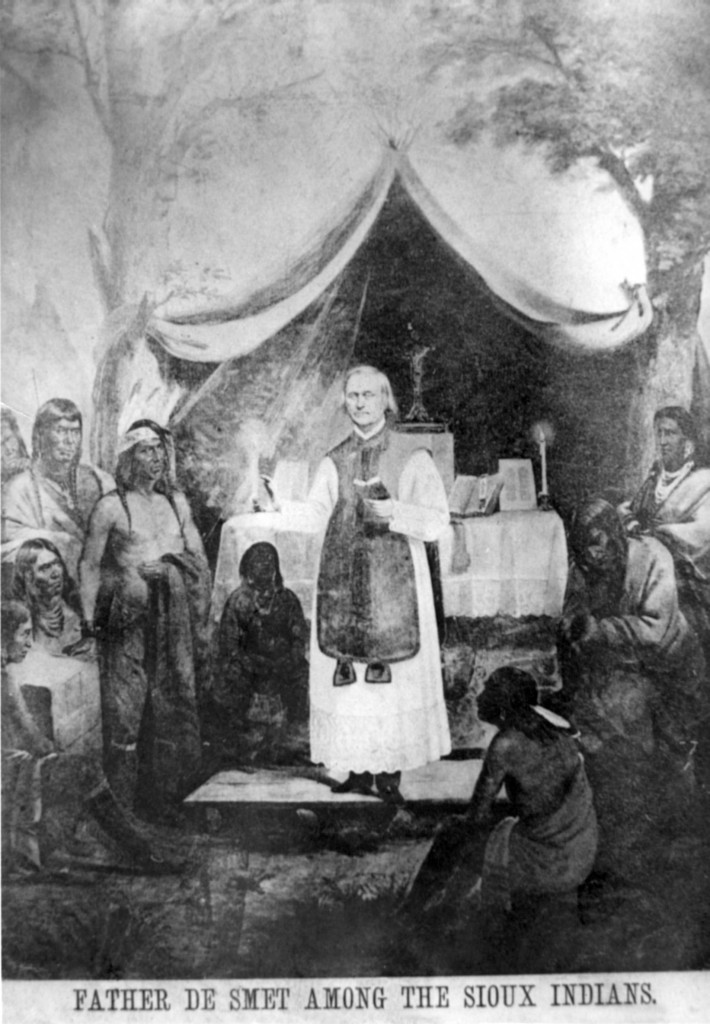
Fr. Pierre-Jean De Smet
Missionary among the North American Indians, born at Termonde (Dendermonde), Belgium, 30 Jan., 1801; died at St. Louis, Missouri, U.S.A., 23 May, 1873. He emigrated to the United States in 1821 through a desire for missionary labours, and entered the Jesuit novitiate at Whitemarsh, Maryland. In 1823, however, at the suggestion of the United States Government a new Jesuit establishment was determined on and located at Florissant near St. Louis, Missouri, for work among the Indians. De Smet was among the pioneers and thus became one of the founders of the Missouri Province of the Society of Jesus.
His first missionary tour among the red men was in 1838 when he founded St. Joseph’s Mission at Council Bluffs for the Pottawatomies. At this time also he visited the Sioux to arrange a peace between them and the Pottawatomies, the first of his peace missions. What may be called his life work did not begin, however, until 1840 when he set out for the Flathead country in the Far North-west.
As early as 1831, some Rocky Mountain Indians, influenced by Iroquois descendants of converts of one hundred and fifty years before, had made a trip to St. Louis begging for a “black-robe”. Their request could not be complied with at the time. Curiously enough, the incident excited Protestant missionary enterprise, owing to the wide dissemination of a mythical speech of one of the delegation expressing the disappointment of the Indians at not finding the Bible in St. Louis. Four Indian delegations in succession were dispatched from the Rocky Mountains to St. Louis to beg for “black-robes” and the last one, in 1839, composed of some Iroquois who dwelt among the Flatheads and Nez Percês, was successful. Father De Smet was assigned to the task and found his life-work.
He set out for the Rocky Mountain country in 1840 and his reception by the Flatheads and the Pend d’Oreilles was an augury of the great power over the red men which was to characterize his career. Having imparted instruction, surveyed the field, and promised a permanent mission he returned to St. Louis; he visited the Crows, Gros Ventres, and other tribes on his way back, travelling in all 4814 miles. In the following year he returned to the Flatheads with Father Nicholas Point and established St. Mary’s Mission on the Bitterroot river, some thirty miles south of Missoula, visiting also the Coeur-d’Alênes.
Realizing the magnitude of the task before him, De Smet went to Europe in 1843 to solicit funds and workers, and in 1844 with new labourers for the missions, among them being six Sisters of Notre-Dame de Namur, he returned, rounding Cape Horn and casting anchor in the mouth of the Columbia River at Astoria. Two days after, De Smet went by canoe to Fort Vancouver to confer with Bishop Blanchet, and on his return founded St. Ignatius Mission among the Kalispels of the Bay, who dwelt on Clark’s Fork of the Columbia river, forty miles above its mouth.
Father De Smet Monument at Lake Desmet between Buffalo and Sheridan Wyoming. Lake Desmet, pictured behind the monument, is a 3600 acre natural lake. Fr. De Smet, after whom the lake is named, described the lake in a letter dated August 24, 1851: “On the 23rd we left Tongue River. For ten hours we marched over mountain and valley, following the course of one of its tributaries, making, however, only about twenty-five miles. On the day following we crossed a chain of lofty mountains to attain the Lower Piney Fork, nearly twenty miles distant. We arrived quite unexpectedly on the borders of a lovely little lake about six miles long, and my traveling companions gave it my name. There our hunters killed several wild ducks.”
As the Blackfeet were a constant menace to other Indians for whom De Smet was labouring, he determined to influence them personally. This he accomplished in 1846 in the Yellowstone valley, where after a battle with the Crows, the Blackfeet respectfully listened to the “black-robe”.
He accompanied them to Fort Lewis in their own country where he induced them to conclude peace with the other Indians to whom they were hostile, and he left Father Point to found a mission among this formidable tribe. His return to St. Louis after an absence of three years and six months marks the end of his residence among the Indians, not from his own choice but by the arrangement of his religious superiors who deputed him to other work at St. Louis University. He coadjutors in his mission labours, Fathers Point, Mangarini, Nobili, Ravalli, De Bos, Adrian and Christian Hoecken, Joset and others, made De Smet’s foundations permanent by dwelling among the converted tribes.
De Smet was now to enter upon a new phase of his career. Thus far his life might be called a private one, though crowded with stirring dangers from man and beast, from mountain and flood, and marked by the successful establishment of numerous stations over the Rocky Mountain region. But his almost inexplicable and seemingly instantaneous ascendancy over every tribe with which he came in contact, and his writings which had made him famous in both hemispheres, caused the United States Government to look to him for help in its difficulties with the red men, and to invest him with a public character.
Henceforth he was to aid the Indians by pleading their cause before European nations and by becoming their intermediary at Washington. In 1851 owing to the influx of whites into California and Oregon, the Indians had grown restless and hostile. A general congress of tribes was determined on, and was held in the Creek Valley near Fort Laramie, and the Government requested De Smet’s presence as pacificator. He made the long journey and his presence soothed the ten thousand Indians at the council and brought about a satisfactory understanding.
Father De Smet with the Indian delegation that accompanied him to Washington, DC.
In 1858 he accompanied General Harney as a chaplain in his expedition against the Utah Mormons, at the close of which campaign the Government requested him to accompany the same officer to Oregon and Washington Territories, where, it was feared, an uprising of the Indians would soon take place. Here again his presence had the desired effect, for the Indians loved him and trusted him implicitly. A visit to the Sioux country a the beginning of the Civil War convinced him that a serious situation confronted the Government. The Indians rose in rebellion in August, 1862, and at the request of the government De Smet made a tour of the North-west.
When he found that a punitive expedition had been determined on, he refused to lend to it the sanction of his presence. The condition of affairs becoming more critical, the government again appealed to him in 1867 to go to the red men, who were enraged by white men’s perfidy and cruelty, and “endeavour to bring them back to peace and submission, and prevent as far as possible the destruction of property and the murder of the whites.” Accordingly he set out for the Upper Missouri, interviewing thousands of Indians on his way, and receiving delegations from the most hostile tribes, but before the Peace Commission could deal with them, he was obliged to return to St. Louis, where he was taken seriously ill.
In 1868, however, he again started on what Chittenden calls (Life, Letters and Travels of Pierre Jean De Smet, p. 92), “the most important mission of his whole career.” He travelled with the Peace Commissioners for some time, but later determined to penetrate alone into the very camp of the hostile Sioux. General Stanley says (ibid.): “Father De Smet alone of the entire white race could penetrate to these cruel savages and return safe and sound.” The missionary crossed the Bad Lands, and reached the main Sioux camp of some five thousand warriors under the leadership of Sitting Bull.
He was received with extraordinary enthusiasm. His counsels were at once agreed to, and representatives sent to meet the Peace Commission. A treaty of peace was signed, 2 July, 1868, by all the chiefs. This result has been looked on as the most remarkable event in the history of the Indian wars. Once again, in 1870, he visited the Indians, to arrange for a mission among the Sioux. In such a crowded life allusion can be made only to the principal events. His strange adventures among the red men his conversions and plantings of missions, his explorations and scientific observations may be studied in detail in his writings. On behalf of the Indians he crossed the ocean nineteen times, visiting popes, kings, and presidents, and traversing almost every European land. By actual calculation he travelled 180,000 miles on his errands of charity.
His writings are numerous and vivid in descriptive power, rich in anecdote, and form an important contribution to our knowledge of Indian manners, customs, superstitions, and traditions. The general correctness of their geographical observations is testified to by later explorers, though scientific researches have since modified some minor details. Almost childlike in the cheerful bouyancy of his disposition, he preserved this characteristic to the end, though honoured by statesmen and made Chevalier of the Order of Leopold by the King of the Belgians.
That he was not wanting in personal courage is evinced by many events in his wonderful career. Though he had frequent narrow escapes from death in his perilous travels, and often took his life in his hands when penetrating among hostile tribes, he never faltered. But his main title to fame is his extraordinary power over the Indians, a power not other man is said to have equalled. To give a list of the Indian tribes with whom he came in contact, and over whom he acquired an ascendancy, would be to enumerate almost all the tribes west of the Mississippi.
Even Protestant writers declare him the sincerest friend the Indians ever had. The effects of his work for them were not permanent to the extent which he had planned, solely because the Indians have been swept away or engulfed by the white settlers of the North-west. If circumstances had allowed it, the reductions of Paraguay would have found a counterpart in North America. The archives of St. Louis University contain all the originals of De Smet’s writings known to be extant. Among these is the “Linton Album”, containing his itinerary from 1821 to the year of his death, also specimens of various Indian dialects, legends, poems, etc. The principal works of Father De Smet are: “Letters and Sketches, with a Narrative of a Year’s Residence among the Indian Tribes of the Rocky Mountains” (Philadelphia, 1843), translated into French, German, Dutch, and Italian; “Oregon Missions and Travels over the Rocky Mountains in 1845-46″ (New York, 1847), translated into French and Flemish; “Voyage au grand désert en 1851″ (Brussels, 1853); “Western Missions and Missionaries” (New York, 1863), translated into French; “New Indian Sketches” (New York, 1865).
The crucifix that Fr. De Smet held on his deathbed. There is another ivory crucifix which was found in his room, which is located in the St. Louis, Missouri Collections. http://www.slu.edu/sluma-home/collections/sluma/jesuit-collections/crucifix
CHITTENDEN AND RICHARDSON, Life, Letters and Travels of Pierre Jean De Smet, S.J. (New York, 1905). It contains many hitherto unpublished letters and a map of De Smet’s travels; DEYNOODT, P. J. De Smet, missionaire Belge aux Etas-Unis (Brussels, 1878); PALLANDINO, Indian and White in the North-west (Baltimore, 1894); U.S. CATH. HIST. SOC., Hist. Records and Studies (New York, 1907), VII.
WILLIAM H.W. FANNING (cfr. Catholic Encyclopedia)





No comments:
Post a Comment